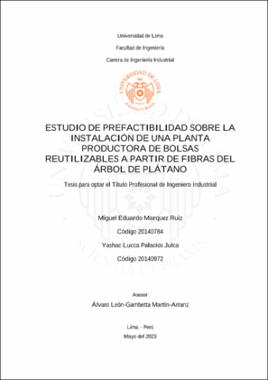| dc.contributor.advisor | León Gambetta Martín Arranz, Álvaro | |
| dc.contributor.author | Marquez Ruiz, Miguel Eduardo | |
| dc.contributor.author | Palacios Julca, Yashac Lucca | |
| dc.date.accessioned | 2023-09-04T16:20:26Z | |
| dc.date.available | 2023-09-04T16:20:26Z | |
| dc.date.issued | 2023 | |
| dc.identifier.citation | Marquez Ruiz, M. E. & Palacios Julca, Y. L. (2023). Estudio de prefactibilidad sobre la instalación de una planta productora de bolsas reutilizables a partir de fibras del árbol de plátano [Tesis para optar el Título Profesional de Ingeniero Industrial, Universidad de Lima]. Repositorio institucional de la Universidad de Lima. https://hdl.handle.net/20.500.12724/18785 | es_PE |
| dc.identifier.uri | https://hdl.handle.net/20.500.12724/18785 | |
| dc.description.abstract | El objetivo de esta investigación descansa en determinar si resulta viable la implementación de una planta productora de bolsas reutilizables a base de fibra del árbol del plátano (Musa x Paradisiaca), desde una perspectiva de mercado, técnica, financiera y social. Cada acápite en este documento busca fundamentar la factibilidad de esta iniciativa. En los capítulos siguientes se confirma que el proyecto es viable y la hipótesis es confirmada.
En el primer capítulo, se comenta acerca de la necesidad de implementar este proyecto dada la coyuntura nacional. Trata de la incipiente urgencia de cuidar el medioambiente, debido al estado degenerativo en el que se encuentra nuestro planeta, así como de la tendencia de los consumidores a elegir productos amigables con la naturaleza. Posteriormente, se calcula la demanda del proyecto, siendo esta de 16,434 kg el primer año y 17,849 kg el último. Nuestras bolsas ecológicas se ofrecerán a un precio de S/16.90.
En el tercer capítulo se especifica en dónde se ubicará la planta manufacturera. Como la merma del cultivo del plátano es el insumo principal para este proyecto, es necesario que se ubique la fábrica en una zona tropical donde se cosechan grandes cantidades de esta fruta. Piura, específicamente en Bellavista se escogió como destino por sus características. Es así como, en el cuarto capítulo se determina que el tamaño máximo de la planta está limitado por el tamaño de mercado, resultando en 17,849 kg.
En el quinto capítulo se detallan todos los aspectos ingenieriles del proyecto, como las dimensiones del producto, su composición, especificaciones de calidad, cantidad de máquinas y operarios, la capacidad de la planta a partir del cuello de botella en la estación de tejido (50,397 kg). En esta sección también se realizó un plano tentativo de las instalaciones de la planta, aplicando la metodología de lean manufacturing. En el capítulo siguiente se describe la estructura organizacional de la empresa.
Para el penúltimo capítulo se evalúa la viabilidad económica y financiera detalladamente. Se obtuvo un VANE de S/ 293,666 con un TIRE de 23%, un B/C de 1.4 y la inversión se recupera en 4 años. Para el caso del flujo financiero, se obtuvo un VANF de S/ 319,101 una TIRF de 30%, B/C de 1.57 y la inversión se recupera en 3.43 años. En el último capítulo, se validó que el proyecto genera beneficios para la sociedad al aplicarle una evaluación social. Finalmente, se presentaron las conclusiones y recomendaciones fruto de esta investigación. | es_PE |
| dc.format | application/pdf | |
| dc.language.iso | spa | |
| dc.publisher | Universidad de Lima | |
| dc.rights | info:eu-repo/semantics/openAccess | * |
| dc.rights.uri | https://creativecommons.org/licenses/by-nc-sa/4.0/ | * |
| dc.source | Repositorio Institucional - Ulima | |
| dc.source | Universidad de Lima | |
| dc.subject | Ecological bags | en_EN |
| dc.subject | Plant fibers | en_EN |
| dc.subject | Banana trade | en_EN |
| dc.subject | Bananas | en_EN |
| dc.subject | Banana family (Plants) | en_EN |
| dc.subject | Prefeasibility studies | en_EN |
| dc.subject | Bolsas ecológicas | es_PE |
| dc.subject | Fibras vegetales | es_PE |
| dc.subject | Industria del banano | es_PE |
| dc.subject | Plátanos | es_PE |
| dc.subject | Familia del banano (Plantas) | es_PE |
| dc.subject | Estudios de prefactibilidad | es_PE |
| dc.title | Estudio de prefactibilidad sobre la instalación de una planta productora de bolsas reutilizables a partir de fibras del árbol de plátano | es_PE |
| dc.title.alternative | Prefeasibility study on the installation of a plant to produce reusable bags from banana tree fibers | en_EN |
| dc.type | info:eu-repo/semantics/bachelorThesis | |
| thesis.degree.level | Título Profesional | |
| thesis.degree.discipline | Ingeniería Industrial | es_PE |
| thesis.degree.grantor | Universidad de Lima. Facultad de Ingeniería y Arquitectura | |
| dc.publisher.country | PE | |
| dc.type.other | Tesis | |
| thesis.degree.name | Ingeniero Industrial | |
| renati.advisor.orcid | https://orcid.org/0000-0002-8523-9701 | |
| renati.discipline | 722026 | |
| dc.identifier.isni | 121541816 | |
| renati.author.dni | 73188185 | |
| renati.author.dni | 72512567 | |
| renati.level | https://purl.org/pe-repo/renati/level#tituloProfesional | * |
| renati.advisor.dni | 44032329 | |
| renati.juror | Urbina Rivera, Carlos Medardo | |
| renati.juror | Meza Ortiz, Richard Nicholas | |
| renati.juror | Montoya Ramirez, Manuel Fernando | |
| renati.juror | León-Gambetta Martín-Garranz, Álvaro | |
| renati.type | https://purl.org/pe-repo/renati/type#tesis | * |
| dc.subject.ocde | https://purl.org/pe-repo/ocde/ford#2.11.04 | |
| ulima.cat | 15 | |





